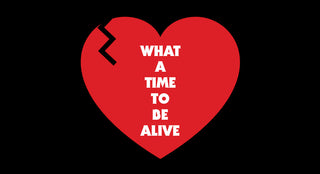“I would not have you descend into your own dream. I would have you be a conscious citizen of this terrible and beautiful world.”
-Ta-Nehisi Coates, Between the World and Me. A quote used in the What a Time to Be Alive show statement.
Slow Culture and Sunday, two independently-owned and run L.A. art galleries, have joined forces to create What A Time to Be Alive, a collaborative group show described as “a critique and celebration of the modern world” whose opening reception is tonight, January 15 from 7-10pm. Both galleries have been open for about 2 years now, but this is the first time they are both hosting a show that hopes to “instigate open and honest conversation between artists and the community on social issues and current events,” according to the show statement. With over 50 artists participating, and brands creating products specific to the show, WATTBA is an ambitious undertaking. A portion of the proceeds from the show will be donated to Inner-City Arts, an arts education provider that fights for art to be accessible for everyone, regardless of socioeconomic class, and Critical Resistance, an organization seeking to end the prison industrial complex through alternative means. Support for the show through exclusive product that will be on sale comes from UNIF, Obey, Huf, Altamont, Vans, Quiet Life, and ourselves, The Hundreds.
Meant to “inform and inspire audiences to pay attention to what has been going on in the world,” a few of the exhibition’s topics range from police brutality to feminism, and racism to pop culture and politics. And though not everyone has to agree, viewers can come together for a safe space of introspection and thoughtful dialogue. Our Editorial Assistant Todd Knaak caught up with Fred Guerrero, gallery owner of Slow Culture and Adi Rajkovic, gallery owner of Sunday, to get a little more insight to how this collaborative show came to be and what conversations they hope will be ignited through art in our edited interview below.
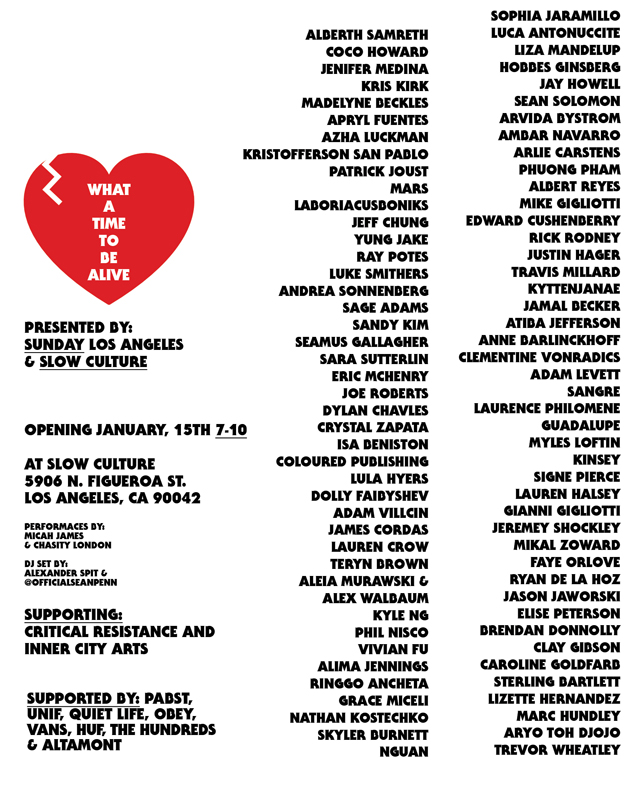
TODD KNAAK: Maybe this is just my personal experience and a massive umbrella statement, but when you text or use social media, people just tend to talk rather than listen—like you’re just talking to each other. In a gallery setting, it seems like it’ll force a deeper listening [of these topics].
FRED/SLOW CULTURE: For us, that’s part of the reason we started a gallery. These things have to have a physical space, art and culture. They have to live in real life, that’s part of [why] we call it Slow Culture. It’s like going back to how things were when you experienced them in real life, not just a Tumblr feed or whatever this blog you follow. It’s a place for people to come and experience these things. And with that, that’s why this show’s important to us because there is substantial subject matter to it. Getting people there to talk about it.
Do you think the Internet, as far as conversations go, has ruined the idea of a conversation, made it easier, or just simply changed it?
ADI/SUNDAY: I think that the way the world is [with the Internet] you can see things that we just weren’t able to see. You can watch fucked up videos way more easily. That’s maybe one thing that’s interesting. But there was so much kept from us. Now people can find anything out. The world literally has lied to you... Our world has been so curated around us for so long because I think there’s always been an amount of control and there still is. But with the Internet, there’s more control with the people because I can post some shit and it can go viral. Like Edward Snowden, that’s incredible. It just has to be used the right way.
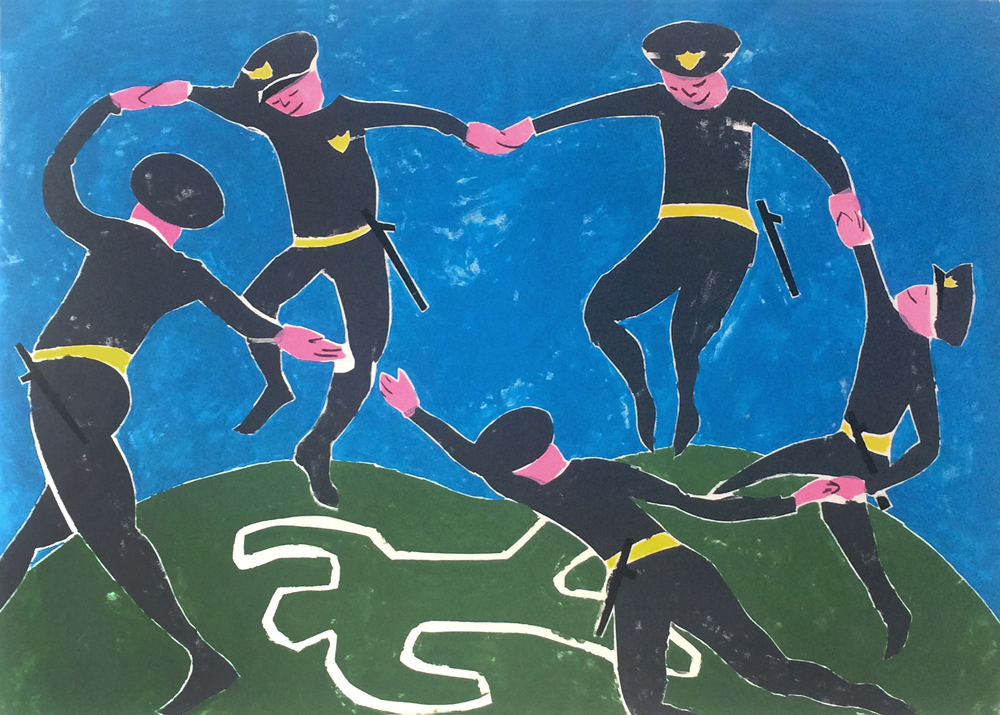
“Dance” by Slow Culture-curated illustrator Sterling Bartlett.
Is art the best vessel to tackle these topics?
ADI/ SUNDAY: It’s so complicated. I feel like I really struggle with political art and activism and art and how all of those merge. For me, that’s something that I [think] about so much. I feel like sometimes with organizations, they’re thinking very directly and they’re not thinking artistically or they have really confusing websites or something because it’s like they don’t have the means to have people that are more creative in that way. But literally, the world is built on advertising and marketing. There are things that are embedded in us that we don’t even know about.
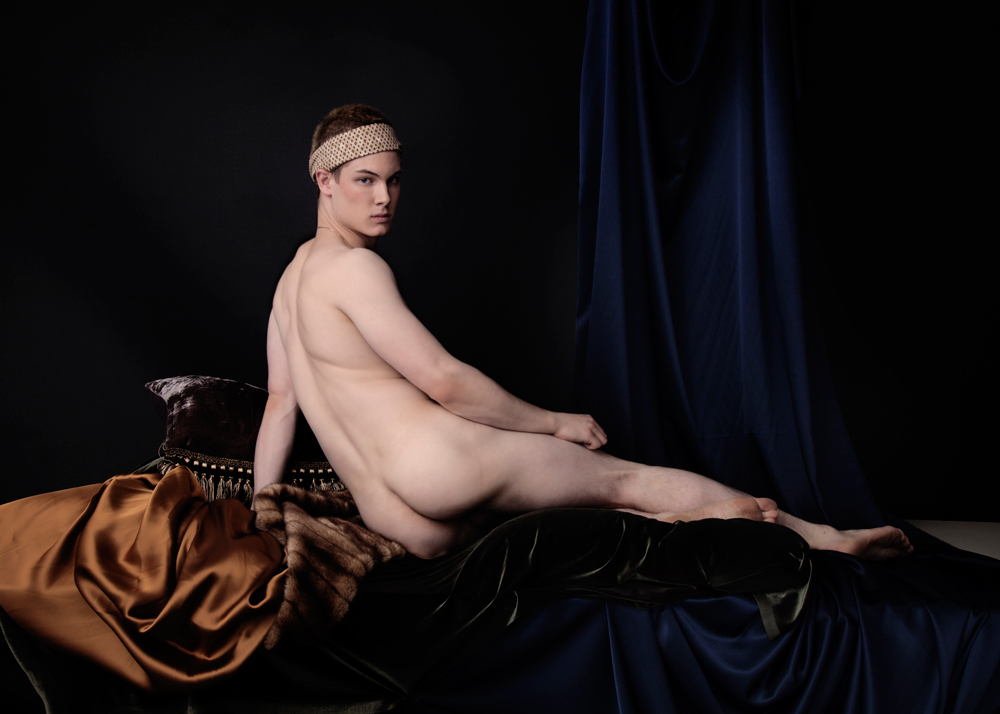
Sunday-curated artist Luke Smithers‘s self-portrait that will be in WATTBA.
So ideally, someone walks into the show—what do you want them to experience? How do you want to them to leave changed? How should they be different when they exit the door?
FRED/SLOW CULTURE: For me, on our side, I hope it just inspires people to do something. That they see that we’re doing something, that we put all this work in to bring these people together. All these artists put in work to make something on this subject or something that they feel passionate about. If anything, I just want people to come in and see it and be like, “I have a voice, I can do something about it. I don’t have to sit behind my computer screen or phone and feel helpless that the world is fucked up. All this shit’s happening and I’m just going to watch it burn.”
I feel like that’s a thing. Sometimes, people feel so helpless, it’s so hard to do something. But you just gotta do it. You can do whatever you want, you can say whatever you want, and if people listen, they listen. But at least you tried—you did something about it.
ADI/SUNDAY: And ultimately, I think it’s about people coming together, and I think that both of us have an established audience that follows us and will come to shows without even knowing what it’s going to be about really. So I think that it’s cool to be able to use the space and the platform that we have to have people see things in a different way possibly. Or maybe it’s how they always saw things, maybe it won’t be any different for some people. I think if it just affects one person even. Just having all of this art and information available… I also do think that working with other organizations and people seeing that there is a physical thing you can do in the world to help [is important].
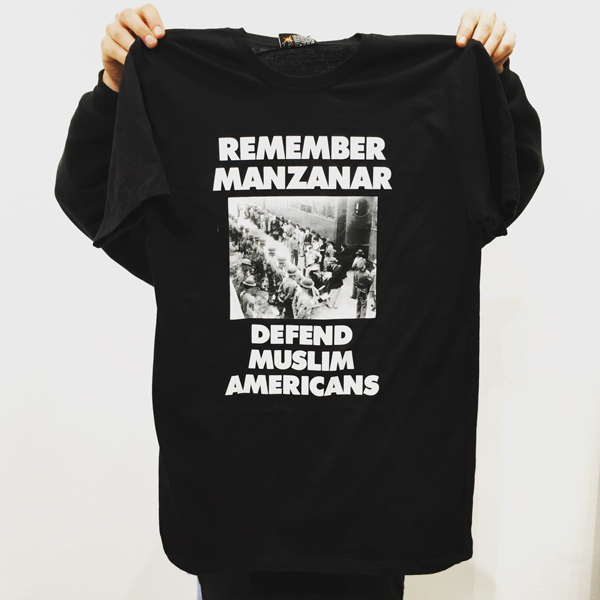
Limited edition shirt designed by Bobby Hundreds for What a Time to Be Alive that will be on sale at the opening.
FRED/SLOW CULTURE: …I just want people to take away from this that you can do something, you can say something. Maybe you’re not going to change the world overnight, but you don’t have to be a bystander.
ADI/SUNDAY: It starts somewhere.
FRED/SLOW CULTURE: You don’t have to be a victim. So many people feel like, “Oh, all this tragic stuff is happening, I’m a victim of the world and these things surrounding me.” No, you can do something, you can start something. All you have to do is speak up.
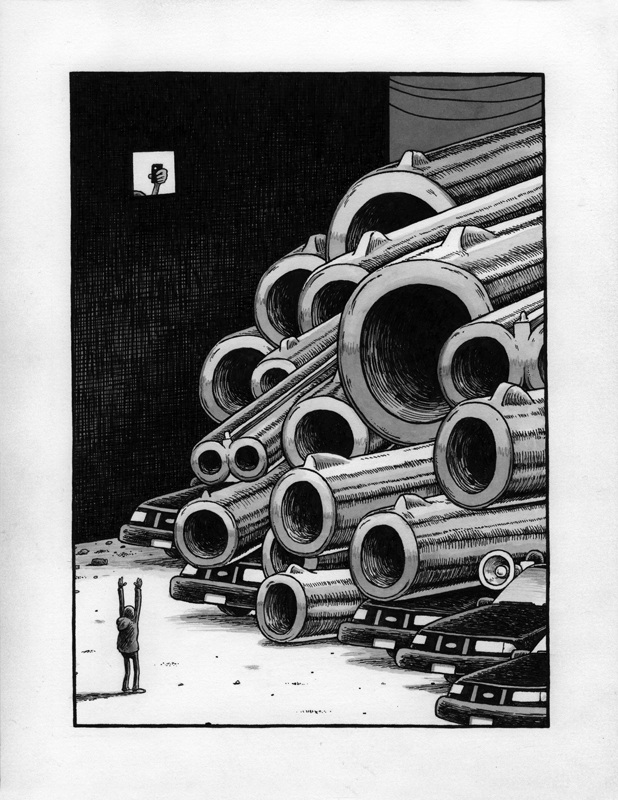
Slow Culture-curated artist Travis Millard’s “Police Story.”
ADI/SUNDAY: Sunday started—and still is—in our living room. We’ve had art shows that way, so yeah, you can have an art show and invite people over and they will come. I think people seeing that you can do that is also interesting. You can do this too.
FRED/SLOW CULTURE: That’s the thing, [the show is] so big, hopefully you take away one thing. There are so many artists, so many things out there. You don’t have to love every piece, you don’t have to love every artist. There are so many different types of art. Hopefully, you just take away one thing like, “Wow, that’s beautiful. That’s powerful.” Whatever it is, I think people will walk in that room and feel something.
***
You can catch the opening reception tonight, January 15, from 7-10PM.
The show runs from January 15 to January 31, located at Slow Culture in Highland Park at 5906 N. Figueroa, LA 90042.
This interview has been edited for clarity.

